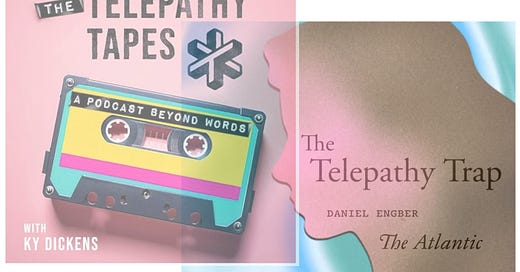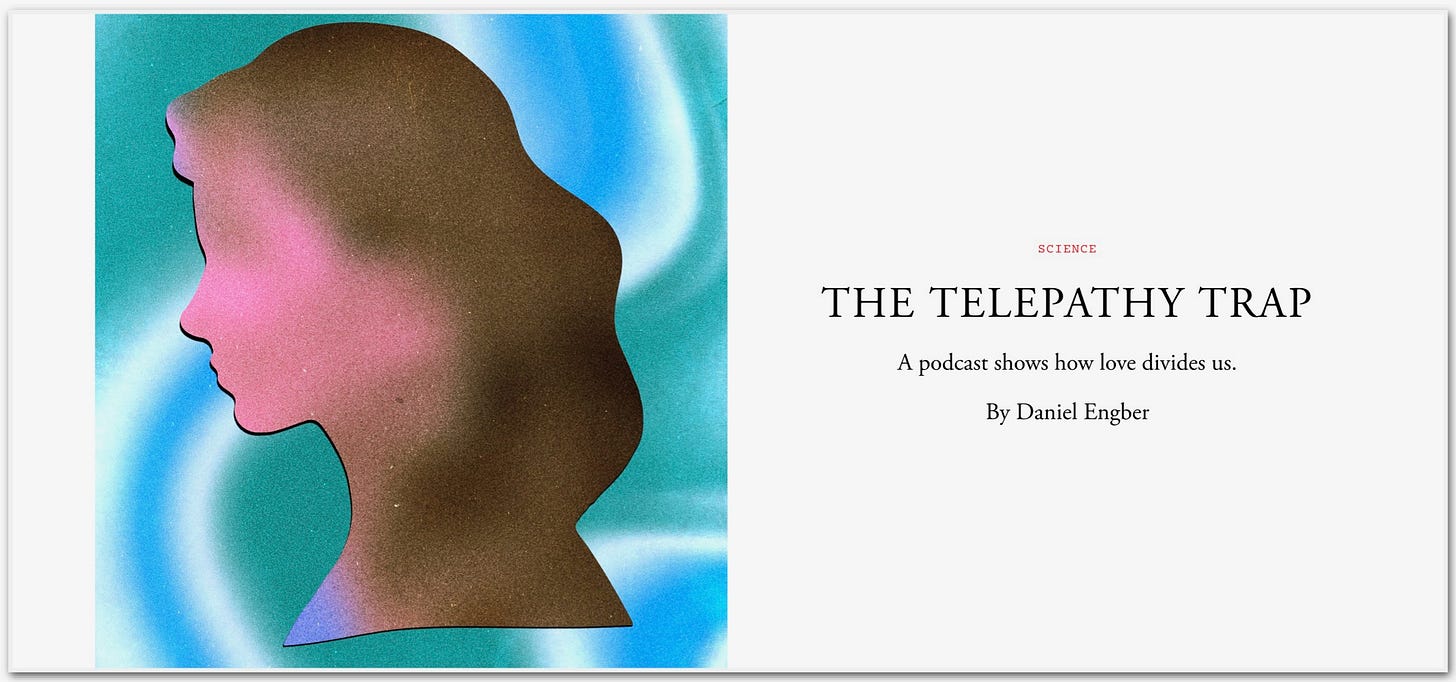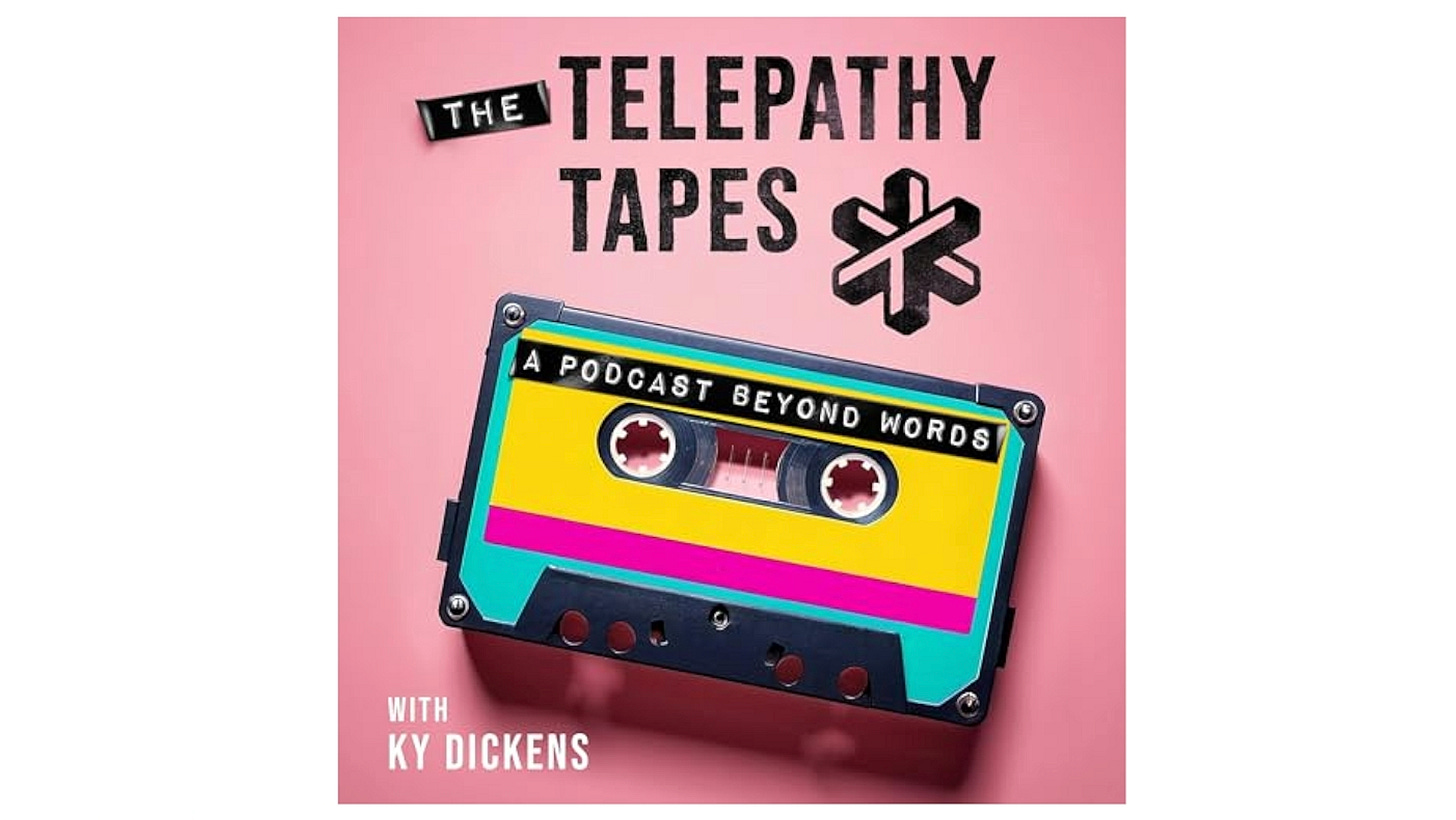The first major takedown of "The Telepathy Tapes" only exposes its own magical thinking
A response to The Atlantic's "The Telepathy Trap"
On March 3rd, The Atlantic magazine published “The Telepathy Trap,”1 Daniel Engber’s takedown of the hit podcast The Telepathy Tapes, which topped the charts at the beginning of this year. On the one hand, his dismissal wasn’t unexpected — if you google “Telepathy Tapes” all you find are repudiations from science blogs and autism websites — but this is the first takedown from a major publication, so my interest was piqued. Would he just attack the people involved (as most critics do), or would he actually try to give an alternative explanation for what The Telepathy Tapes describe? Explaining such phenomena is the far more difficult path, and I hoped that a major publication might require it. I was not disappointed.
First, let’s take a look at the phenomenon. The Telepathy Tapes document the purported telepathic abilities of non-speaking autistic children. Basically, there are a number of cases where parents and teachers are saying their kids can read their minds. Many of these claims come in the form of personal stories — truly strange and fascinating stories — but there are also a number of tests that have been done over the years.
And this is where The Telepathy Tapes start: The first two episodes conduct such tests to some pretty shocking results. For example, the parents are shown randomly generated numbers, words, and pictures, and without actually seeing those things themselves, the children say exactly what they are. Over and over again. Without making mistakes (at least none that we hear about).
But how do the children “say” such things if they’re unable to speak? Here’s where “facilitated communication” — or what’s known as FC — comes in, the controversial centerpiece of this whole story. These children have all learned to communicate using FC, or related methods such as Rapid Prompting and Spelling to Communicate. With all these methods, the children are assisted by a facilitator to type on a keyboard or point to symbols on a letter board. Remember, these children have severe disabilities; many of them have little control over their own bodies. So when they first learn these methods, their wrist is touched and given pressure in the process. When they’ve gained enough mobility there, then their arm or shoulder is touched. Eventually the facilitator might just touch their forehead or chin. And these methods have evolved even further still… but more on that later.
Through this process, the child’s world is unlocked and often a rich inner life pours out of them, sometimes in the form of poetry and philosophy. As you can imagine, many of these children have been thought of as extremely low-functioning, low-IQ individuals, so this turns that characterization on its head.
When FC was first introduced in the 90s it became hugely popular, but then something terrible happened. Cases arose where some of the children, working with their facilitators at school, made allegations of sexual abuse against their parents. These cases were taken to court, and the question was asked — Are these communications reliable? How do we know the kids are actually saying these things and they’re not somehow being manipulated by their facilitators?
So they created some simple experiments to find out. If the children are really communicating their own experiences, then they should be able to do so even if the facilitators know nothing about those experiences. So they set up tests where the facilitators saw one image and the children another. When they then asked the children to write down what they’d seen, the children failed to do so again and again and would instead write down what the facilitators saw. (This was all documented in the Frontline report “Prisoners of Silence.” You can watch it on YouTube, where the tests referred to start at 24:52, or on PBS, where the tests start at 24:40)
Well, that was a major shock and setback for FC. The facilitators all thought they were unlocking the inner life of these children, but somehow the communications depended on the facilitators themselves. As Engber says in his article, these tests “suggested that [the children] were not actually — or not entirely — the authors of the words they’d been typing.”
Just to be clear: no one thinks the facilitators were consciously manipulating the children — that they composed these messages and then forced the kids to write them. No, everyone seems to think that the whole thing was taking place in the subconscious. As the author of an article in the Skeptical Inquirer put it, “the facilitators were unaware they were doing the typing.” And so the analogy that’s always repeated is that of a Ouija board — we might think there are spirits sending messages from the other side, but really it’s just our subconscious talking.
So that might have been the end for FC, but it turns out that most parents didn’t really care about these tests. As Engber puts it, “You could puzzle over tables in someone’s published meta-analysis… or you could keep on talking to your son.” Parents didn’t want to stop talking with their kids, so they continued, even as FC was pushed farther and farther towards the fringe.
While the world went back to treating these kids as mute, FC continued to evolve along its own lines. And there were a number of significant developments over the years. One major one was that some of the children began to write on their own, without any assistance, often using an iPad or computer, as we see in Episode 2 of The Telepathy Tapes with the 10 year old boy from New Jersey, Akhil. And another major one was, of course, that some of the facilitators began to claim that the kids were reading their minds.
Now that claim might be too much for some of you. First FC claimed that all these kids were poets and philosophers, which was debunked. Now they’re claiming these kids are telepathic too?
But before dismissing this claim out of hand, it’s worth dwelling on it for a moment. The original claims were debunked precisely because there was some sort of subconscious merging happening between the kids and the facilitators. They weren’t considered “original communications” from the children because the children were somehow linked to the facilitators, seeing through their eyes. The kids couldn’t express what they saw, only what the facilitator saw.
So the skeptics’ position doesn’t actually make much sense. They want to dismiss the claims of telepathy found in The Telepathy Tapes by showing that it’s connected to FC, which was debunked. But FC was debunked by showing that the kids were doing something that looks a lot like telepathy…
Unfortunately, most skeptics writing about The Telepathy Tapes never bother to address this basic flaw in their argument. Instead they spend all their time smearing the people who made the podcast and pointing to the shadowy history of FC.
But while Engber does some of this as well, he also tries to explain the phenomenon. Great! Clearly something strange and amazing is happening here. No one thinks it’s fraud. No one is saying that it’s some giant hoax being perpetrated by all these parents and teachers. So if it’s not telepathy, what is it?
Early on in the article Engber says, “In assuming a reality where reading minds is possible and astral planes can be traversed, [The Telepathy Tapes] misses something more compelling: Humans really do possess a superpower for connection, with unpredictable effects.” OK, so what exactly is this new “superpower” that’s not just magical, new age wool-spinning, but good, solid, factual science? Here’s the explanation he finally gives at the article’s conclusion:
After many years of practice spelling with his mother, [Akhil] now appears to do so independently, typing on an iPad keyboard without ever being touched at all, and with no one’s hand on his device.
But a closer look suggests that his mother is still guiding him, even though she may not realize it. She does not touch him, but she is highly active all the same: She issues words of encouragement and makes other sounds; she flutters her hands in concert with his typing; and she adjusts her posture while he’s reaching for the screen, as if her body were a joystick. One of the video clips shows an experiment in which he spells out mariposa. You can see his mother in the background, leaning to the right as Akhil’s finger moves in that direction to type out i-p-o; and then moving leftward, as his finger does the same, for s-a.
If such cuing, rather than the spirit realm, is the source of Akhil’s messages, then one must still acknowledge that he has extraordinary talents. For this mode of spelling to “work” as well as it does, Akhil would need to possess an exquisite sensitivity to his mother’s subtle cues; he’d have to be so attuned to her every gesture and expression, that even chirps and leans and flutters could serve as radar signals, directing him to specific letters on the screen. In other words, he’d need to have special access to his mother’s mind.
This is not telepathy, but it is connection — a connection so intense that I don’t think it would be far off to call it love…
So instead of admitting any possibility that these children might be communicating mind-to-mind, Engber describes them as geniuses at reading social cues. Let me remind you that autistic people are usually regarded as unable to read social cues at all — gestures, facial expressions, and tone of voice are often considered totally beyond the pale. But now these children have learned their parent’s subtle “chirps and leans and flutters” so well that they can type them out on a keyboard with 100% accuracy — something you could never train your neurotypical child to do in a thousand years.
Not only that though, in the video clip mentioned above, as well as all the other ones listed on The Telepathy Tapes website,2 Akhil is able to do this miraculous feat without ever once even looking at his mother.
And Engber is so sure of his conclusion: “This is not telepathy.” He knows it’s not telepathy, a phenomenon which has actually been studied by scientists over the decades and centuries and for which there are actual peer-reviewed papers. Instead? It’s love. That’s the hard, factual, scientific answer.
To me, this seems the very definition of magical thinking. One is so committed to one’s worldview — in this instance, materialism — that one has to twist one’s logic into the most fantastic contortions in order to make the phenomenon fit into it. But it’s far better than the alternative: Most skeptics will place their head in the sand and just ignore the phenomenon entirely.
But think how much is lost in the process! OK, let’s assume it’s not telepathy — isn’t the phenomenon still so interesting, so widespread and incredible, that scientists should be flocking to it in order to try to understand it? If scientists really strove for balanced, objective, open-minded inquiry wouldn’t they be busy setting up their own experiments? Wouldn’t they want to expand the horizons of science, and not just dismiss anything that happens to stray beyond its conventional walls?
Forget scientists — we all form our own opinions — why wouldn’t we want to expand our horizons when we hear about such phenomena? Instead, we’re like little mob bosses defending our little territory, our little version of reality, immediately attacking anything that disturbs it.
And all of this is just the tip of the iceberg. Everything I’ve described so far, everything that the skeptics criticize, is covered in just the first two episodes of The Telepathy Tapes. After that, there are still eight more episodes describing fascinating stories and further developments in the work that’s being done with these children — how some teachers have learned to distinguish when the kids are parroting back the teacher’s thoughts or expressing their own (remember, this was the major concern about FC back in the 90s); how many children have, independent of one another, described a telepathic space they call “the hill” where they gather to talk; how some teachers and parents have learned to communicate telepathically with their kids; and many other truly wild revelations. All of it is interesting, all of it worth listening to. And I would add: all of it worth investigating by the scientifically-minded.
At this point, I haven’t said what I think is going on here. The truth is I don’t know, though I have ideas. When I heard about The Telepathy Tapes, I actually wasn’t very interested (there’s only so much one can take in). But when I gave it a listen and realized there was some legitimacy to it, I was intrigued. Then I wanted to talk to people who I thought might be able to shed some light on this phenomenon — people who have worked with such children in the Camphill movement out of Karl König and Rudolf Steiner’s spiritual insights. So I set up an interview with them, which you’ll find below in both video and podcast form. Hope you find it as illuminating as I did!
Understanding The Telepathy Tapes in the light of Rudolf Steiner's anthroposophy
On Tuesday, March 18th, I sat down to discuss The Telepathy Tapes and Rudolf Steiner's anthroposophy with three longtime teachers — Gleice da Silva, Jan Göschel, and Becky Rutherford — all of whom have worked extensively with children with developmental disabilities.
Yes, writers have to eat, but paywalls just punish low-income people, and why shouldn’t they have access to the writing and ideas they want?
All these videos are behind a $10 paywall and there’s no way around it that I know of :)







I, like you, came late to the Telepathy Tapes for many of the same reasons as you. And, just like you I was drawn in by the seemingly inexplicable nature of what was being described. I’m becoming more comfortable with the knowledge, so eloquently stated by Werner Heisenberg. “Not only is the universe stranger than we think, it’s stranger than we can think.” Materialism is circling the drain.
Its very hard to blindly accept something a person has not directly experienced. That's a given. It's also harder to accept something your mind is closed on. There is a large group of humanity that will never accept simple psychic awareness so that telepathy is like riding to Mars on a skateboard. I am telepathic, so are several people around me. It's natural. It's an innate part of all humans. But just not allowed in our social world. Yet in the next coming years, it will become a way of life for many. As a telepath, I actually can communicate easy with children, not just autistic children. They have not closed down their innate nature yet. Just like people back in the 1800's would never accept even the idea of telephones, so too we find the struggle of understanding humanity as more than useless eaters